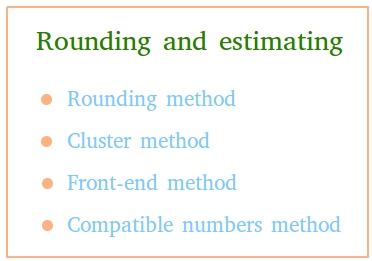What are Rounding and Estimating?
Rounding and estimating are fundamental mathematical techniques that simplify numbers and calculations, making them more manageable in everyday situations. Whether you're budgeting, cooking, or analyzing data, these skills enhance numerical comprehension and facilitate quicker decision-making.
Rounding and Estimating Quiz
Understanding Rounding
Rounding involves adjusting a number to a specific degree of precision, typically to the nearest ten, hundred, or decimal place. This process makes numbers easier to work with without significantly altering their value.
Example: Suppose you have the number 16.87. Rounding this to the nearest whole number gives you 17. This simplification is useful in contexts where exact precision is unnecessary.
When is Rounding Necessary?
Rounding is essential in various scenarios, including:
- Budgeting: Precise figures can be cumbersome. For instance, instead of tracking expenses to the penny, you might round costs to the nearest dollar for simplicity.
Example: If your monthly rent is $1,235, you might round it to $1,200 to streamline your budget planning.
- Cooking: Recipes often require measurements that are easier to handle. Rounding can simplify ingredient quantities without compromising the dish.
Example: Instead of using 2.7 cups of flour, you might round to 3 cups for convenience.
- Statistics and Data Presentation: When presenting data, especially large datasets, rounding helps maintain clarity and readability.
Example: An average score of 78.6 can be rounded to 79 to make reports more straightforward.
Understanding Estimating
Estimating provides an approximate value rather than an exact one. This technique is invaluable when quick assessments are needed, and precision is less critical.
Example: Imagine you’re tracking your weight loss over a year. The pounds lost each month are as follows: 2.4, 2.5, 2.6, 2.3, 2.45, 2.60, 2.41, 2.35, 2.56, 2.49
Instead of adding each precise figure, you can estimate by rounding each to 2.5 pounds. Multiplying 2.5 by 10 months gives an estimated total loss of 25 pounds.
When is Estimating Necessary?
Estimating is useful in situations where:
- Time Constraints: When decisions need to be made quickly, such as during a meeting or while shopping.
Example: Estimating whether you have enough money for groceries without calculating each item’s exact price.
- Complex Calculations: When dealing with large numbers or complex operations, estimates can provide a quick sense of scale.
Example: Estimating the total cost of a home renovation project by rounding individual expenses.
- General Assessments: When precision is less important than the overall trend or pattern.
Example: Assessing whether a team is generally improving in performance without analyzing every game statistic in detail.
Some Key Techniques for Rounding and Estimating

Rounding to the Nearest Whole Number:
- If the decimal is 0.5 or higher, round up.
- If the decimal is less than 0.5, round down.
Example: 3.6 rounds to 4, while 3.4 rounds to 3.
Rounding to a Specific Decimal Place:
- Decide the level of precision needed.
- Apply the rounding rules based on the digit following the desired place.
Example: Rounding 2.456 to two decimal places gives 2.46.
Cluster Estimation:
- Group similar numbers to find an average or representative value.
Example: From the weight loss figures (2.4, 2.5, 2.6, etc.), identifying that most values cluster around 2.5 pounds.
Front-End Estimation:
Focus on the leading digits and ignore the rest.
Example: Estimating 198 + 47 by considering 200 + 50 = 250. Leading digit is 1 for 198, so we round to the nearest hundred and ignore any digit after 1 by replacing them with zero(s). Leading digit is 4 for 47, so we round to the nearest ten and ignore any digit after 4 by replacing them with zero(s).
Practical Applications
Rounding:
- Everyday Shopping: When making purchases, rounding prices to whole numbers can simplify budgeting. For example, if five items are priced around $9.75 each, rounding each to $10 helps quickly estimate a total of $50.
- Travel Planning: Estimating travel time by rounding distances and average speeds allows for better scheduling and time management.
- Financial Planning: Rounding monthly expenses and incomes aids in creating realistic budgets. For instance, if your income is $3,245, rounding to $3,200 makes it easier to allocate funds without getting bogged down by exact figures.
Estimating:
- Project Management: Estimating the time and resources needed for tasks helps in setting realistic deadlines and expectations.
- Health and Fitness: Tracking progress, such as weight loss or workout durations, through estimates can motivate without the pressure of exact numbers.
- Construction: Estimating materials needed for building projects ensures that you purchase sufficient supplies without excessive precision.